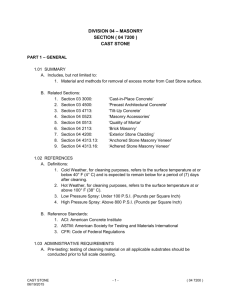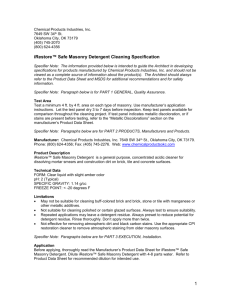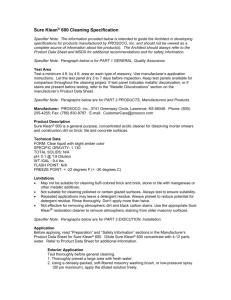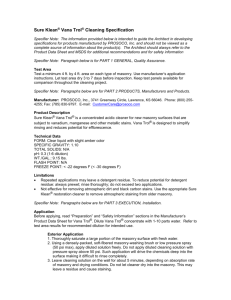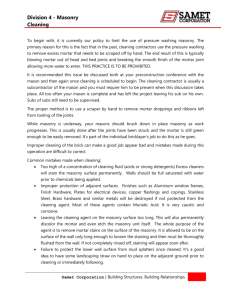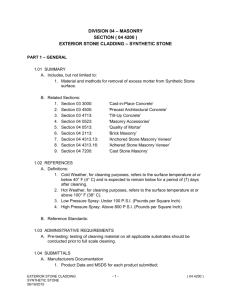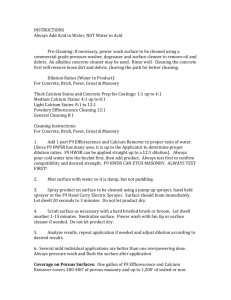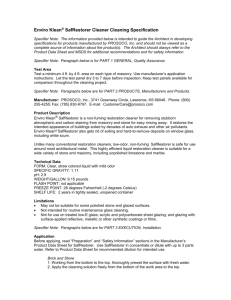Concrete Unit Masonry
advertisement
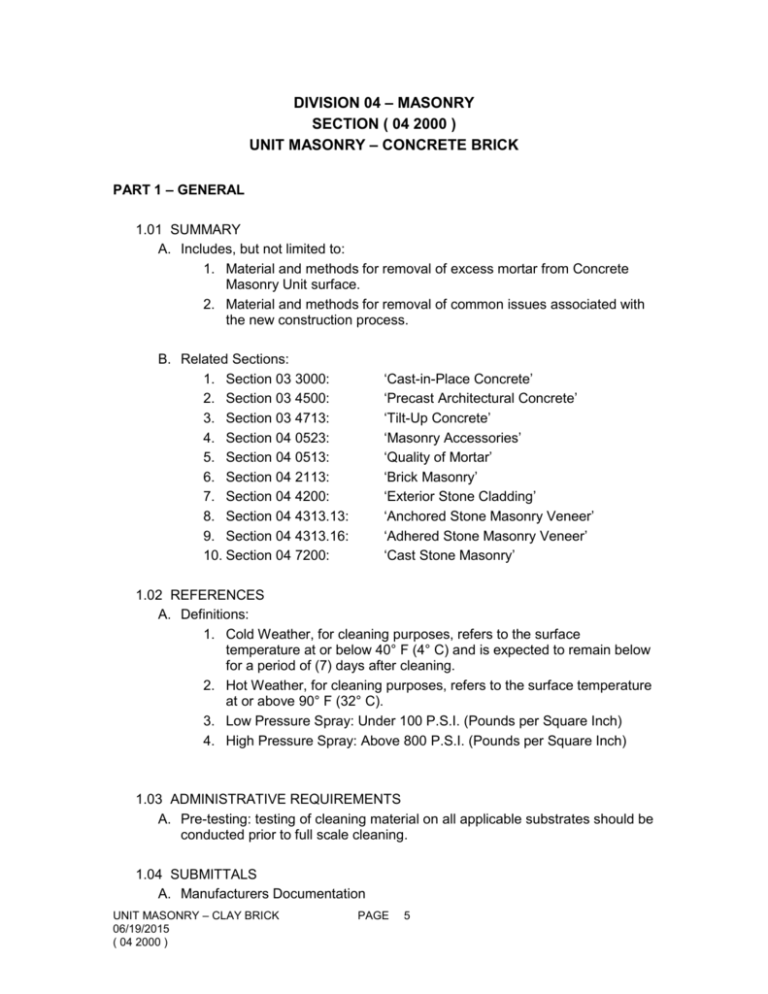
DIVISION 04 – MASONRY SECTION ( 04 2000 ) UNIT MASONRY – CONCRETE BRICK PART 1 – GENERAL 1.01 SUMMARY A. Includes, but not limited to: 1. Material and methods for removal of excess mortar from Concrete Masonry Unit surface. 2. Material and methods for removal of common issues associated with the new construction process. B. Related Sections: 1. Section 03 3000: 2. Section 03 4500: 3. Section 03 4713: 4. Section 04 0523: 5. Section 04 0513: 6. Section 04 2113: 7. Section 04 4200: 8. Section 04 4313.13: 9. Section 04 4313.16: 10. Section 04 7200: ‘Cast-in-Place Concrete’ ‘Precast Architectural Concrete’ ‘Tilt-Up Concrete’ ‘Masonry Accessories’ ‘Quality of Mortar’ ‘Brick Masonry’ ‘Exterior Stone Cladding’ ‘Anchored Stone Masonry Veneer’ ‘Adhered Stone Masonry Veneer’ ‘Cast Stone Masonry’ 1.02 REFERENCES A. Definitions: 1. Cold Weather, for cleaning purposes, refers to the surface temperature at or below 40° F (4° C) and is expected to remain below for a period of (7) days after cleaning. 2. Hot Weather, for cleaning purposes, refers to the surface temperature at or above 90° F (32° C). 3. Low Pressure Spray: Under 100 P.S.I. (Pounds per Square Inch) 4. High Pressure Spray: Above 800 P.S.I. (Pounds per Square Inch) 1.03 ADMINISTRATIVE REQUIREMENTS A. Pre-testing: testing of cleaning material on all applicable substrates should be conducted prior to full scale cleaning. 1.04 SUBMITTALS A. Manufacturers Documentation UNIT MASONRY – CLAY BRICK 06/19/2015 ( 04 2000 ) PAGE 5 1. Product Data and MSDS for each product submitted; 2. Supporting information, i.e. literature as requested. 1.05 QUALITY ASSURANCE A. Mockup Panel 1. Clean mockup panel using the chemical manufacturers’ recommended cleaning method. 2. Allow mockup panel to completely dry prior to evaluating cleaning results. 3. Do not proceed with full scale cleaning until Architect has accepted the cleaning results. 1.06 DELIVERY, HANDLING AND STORAGE A. Storage and Handling Requirements 1. Chemicals may be stored in cold weather temperatures, but should be brought indoors prior to usage. 2. Chemicals should be handled according to manufacturers’ safety procedures. PART 2 – PRODUCTS 2.01 MATERIALS A. Cleaning Materials for Mortar Removal 1. Acid-Based Cleaner: Manufacturers’ standard acidic new masonry cleaner composed of buffered hydrochloric acid. a. EaCo Chem, Inc.: NMD 80 2. Non-Hydrochloric Acid Based Cleaner: Manufacturers’ standard nonhydrochloric acid new masonry cleaner composed of organic salts. a. EaCo Chem, Inc.: SOS 50 B. Cleaning Materials for Common Issues 1. Water Soluble Salts (efflorescence) Remover: Manufacturers’ proprietary cleaner designed to remove calcium chloride (efflorescence) and help prevent its return. a. EaCo Chem, Inc.: EF-Fortless b. EaCo Chem, Inc.: NMD 80 2. Calcium Carbonate (calcite) Remover: Manufacturers’ proprietary twostep system designed to remove calcium carbonate (calcite) deposits. a. EaCo Chem, Inc.: Calcite Presoak followed by NMD 80 b. EaCo Chem, Inc.: Calcite Presoak GEL followed by NMD 80 3. Calcium Silicate (white scum) Remover: Manufacturers’ proprietary two-step system designed to remove calcium silicate (white scum) deposits. UNIT MASONRY – CLAY BRICK 06/19/2015 ( 04 2000 ) PAGE 5 a. EaCo Chem, Inc.: White Scum Presoak followed by NMD 80 2.02 MANUFACTURER A. New masonry cleaner manufacturer contact information: EaCo Chem, Inc.; 765 Commerce Ace, New Castle, PA 16101 – Phone: 800-313-8505, Fax: 724-656-0757 – HYPERLINK "mailto:info@eacochem.com" info@eacochem.com – HYPERLINK "http://www.eacochem.com" www.eacochem.com B. Calcium-based cleaner manufacturer contact information: EaCo Chem, Inc.; 765 Commerce Ave, New Castle, PA 16101 – Phone: 800-313-8505, Fax: 724-656-0757 – HYPERLINK "mailto:info@eacochem.com" info@eacochem.com – HYPERLINK "http://www.eacochem.com" www.eacochem.com C. Non-calcium based cleaner manufacturer contact information: EaCo Chem, Inc.; 765 Commerce Ave, New Castle, PA 16101 – Phone: 800-313-8505, Fax: 724-656-0757 – HYPERLINK "mailto:info@eacochem.com" info@eacochem.com – HYPERLINK "http://www.eacochem.com" www.eacochem.com PART 3 – EXECUTION 3.01 MASONRY CLEANING SPECIALIST A. Masonry Cleaning Specialist Firms: Subject to compliance with requirements, [provide masonry cleaning specialist firms requirements] 3.02 PROTECTION A. Protect adjacent and surrounding surfaces not intended to be cleaned from exposure to the cleaning chemical to prevent damage. B. Prevent cleaning chemical from coming into contact with people, motor vehicles, landscaping and other building materials that could be harmed by such contact. C. Follow cleaner manufacturers’ recommendations for personal protection. 3.03 APPLICATION – REMOVING MORTAR A. After mortar has cured for a period of 7 days, the cleaning process can begin. 1. Beginning from the top of the wall, lightly pre-wet or pre-cool the wall; 2. Begin applying cleaning material from the top to bottom, using even, overlapping passes to ensure full coverage of chemical on the surface; a. Apply cleaning material to the entire drop or section of wall that can be cleaned without allowing the chemical to dry on the surface. UNIT MASONRY – CLAY BRICK 06/19/2015 ( 04 2000 ) PAGE 5 3. After the first application of cleaning material, scrape the large chunks with a long handled scrapper from the first 8 feet of wall; a. Use a scrapper in accordance to masonry manufacturers’ requirements. 4. Check smears and tags to see if they crumble easily; 5. If needed, repeat application to melt remaining residue and extend dwell time; 6. After re-application, scraping can be done further down the wall; 7. Once smears and tags crumble easily, begin rinsing from top down. A thorough rinse is necessary to avoid leaving any cleaning material on the surface or in the masonry unit. a. Use long even strokes that overlap each other. b. Rinse pressure is determined by the masonry manufacturers’ requirements. Color sensitive surfaces should always be rinsed with low pressure. 3.04 APPLICATION – COMMON ISSUES A. Water Soluble Salts (efflorescence) Removal: 1. Apply proprietary cleaner in accordance to manufacturers’ instructions based on pre-tested and pre-approved area. a. Use an acid resistant sprayer to apply cleaner evenly over the affected areas. b. The product will foam upon contact with the stains. When the foaming ceases; apply another application to the affected areas. Continue re-applying until there is no more foam on contact. c. Rinse material according to product instructions. B. Calcium Carbonate (calcite) Removal: 1. Apply proprietary two-step system in accordance to manufacturers’ instructions based on pre-tested and pre-approved area. a. Use an acid resistant sprayer to apply the first step evenly over the affected areas. Rinse the runoff before it can set on un-affected areas. b. The product will foam upon contact. Allow to dwell for a predetermined time. Repeat until a scratch test shows the calcite has been softened. c. Use an acid resistant sprayer to apply the second step evenly over the affected areas. d. Rinse material according to product instructions. e. Repeat above steps as necessary. C. Calcium Silicate (white scum) Removal: 1. Apply proprietary two-step system in accordance to manufacturers’ instructions based on pre-tested and pre-approved area. UNIT MASONRY – CLAY BRICK 06/19/2015 ( 04 2000 ) PAGE 5 a. Use an acid resistant sprayer to apply the first step evenly over the affected areas. Rinse the runoff before it can set on un-affected areas. b. The product will foam upon contact. Allow to dwell for a predetermined time. c. Use an acid resistant sprayer to apply the second step evenly over the affected areas. d. Rinse material according to product instructions. e. Repeat above steps as necessary. D. Vanadium or Manganese Removal: 1. Apply proprietary cleaner in accordance to manufacturers’ instructions based on pre-tested and pre-approved area. a. Use an acid resistant sprayer to apply cleaner evenly over the affected areas. b. Allow to dwell for a pre-determined time. c. Rinse material according to product instructions. d. Repeat above steps as necessary. 3.03 FINAL CLEANING A. Clean site of all unused cleaning material, residues, rinse water, wastes and protection material in accordance with federal and local environmental regulations. END OF SECTION UNIT MASONRY – CLAY BRICK 06/19/2015 ( 04 2000 ) PAGE 5
